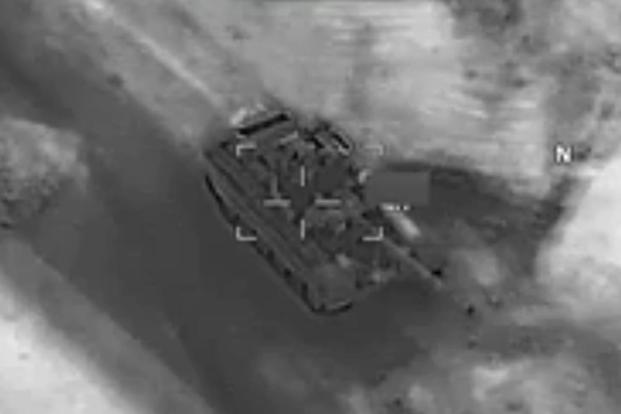A U.S. MQ-9 Reaper drone took out a Soviet-made T-72 tank in eastern Syria on Saturday in a "self-defense" strike after pro-regime forces fired on U.S. advisers and allied Syrian fighters.
Lt. Gen. Jeffrey Harrigian, head of Air Forces Central Command, acknowledged Tuesday that the battlespace in Syria is becoming increasingly contested as more operators move into the area, making response decisions ever more complicated.
"... We rely upon our folks who are on the ground to make that decision, primarily the ground force commander," Harrigian told reporters from the Combined Air Operations Center at Al Udeid Air Base, Qatar, during a video teleconference briefing.
"What happened in that particular scenario is the tank that fired was within an effective range to target our SDF and advisers on the ground, which clearly provides [the ground commander] the ability to defend himself. And he made that decision, appropriately so, and that was the result," he said.
Related content:
- US Scrambles Firepower to Defend SDF Against Pro-Assad Forces
- General: US Pilots Made the Call to Shoot Down Syrian Aircraft
- US Launches Rare Strike on Syrian Government-Backed Troops
Harrigian would not speculate on who was operating the tank -- Russian forces or those belonging to Syrian President Bashar al-Assad. He said he was not aware of any other provocations against the coalition that day.
The MQ-9 mission occurred the same day an Iranian drone was downed over Israel. Israel launched a counterattack "on Iranian targets" in Syria in response to the drone's intrusion, during which an Israeli F-16 was targeted and crash landed back in Israeli territory.
"We fully support Israel's right to defense themselves, particularly against threats to their territory and their people," Harrigian said.
The attacks come days after pro-Assad forces attacked the Syrian Defense Forces in Deir el-Zour Province. The U.S. on Feb. 7 launched significant air and firepower in response to protect coalition service members working with the SDF in an advise, assist and accompany capacity.
Related Video:
The U.S. sent up F-22A Raptor advanced stealth fighters, along with MQ-9 drones, to watch as a three-hour battle began Feb. 7, while "a variety of joint aircraft and ground-based artillery responded in defense of our SDF partners, including F-15E Strike Eagles," Lt. Col. Damien Pickart, AfCent spokesman, told Military.com last week.
Harrigian on Tuesday says officials are still assessing how many pro-regime forces were killed as a result but estimates it was approximately 100. Other reports suggest that more than 200 were killed, with a number of news outlets saying the militants were made up of Russian mercenaries.
Harrigian would not comment on the makeup of the forces.
"What we saw coming at us was approximately a battalion-sized unit," he said. "We continue to look at what those forces were composed of … and it's going to take some time to fully understand who was down there … and there's a fair number of groups involved with this, and it's always difficult to sort that out."
He added, "This is executed as self- defense, and we are going to defend ourselves. We all need to be crystal clear about that. We're going to do that first -- defend ourselves appropriately -- and then … we've got to work through exactly who it was to understand [the threat]."
U.S. forces will continue to watch the area, but Harrigian noted the goal "is to get back to fighting" the Islamic State.
"It clearly is a very complicated and complex environment," he said. "For both our forces on the ground and ... for our forces in the air, this environment requires the professionalism and discipline of a force that's able to manage and understand the environment in such that we can make timely decisions and understand how were going to protect ourselves, and get after the ISIS fight."











